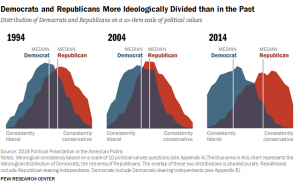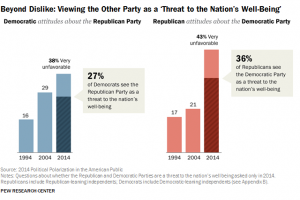Party Loyalty from Politicians
Chapter nine discusses the importance and effect the two party system has on American governance and American politics. The role of party identification is also discussed at length, and I find it interesting to not only consider party loyalty from the general populous, but from within the party itself. For a political candidate there seems to be a delicate line between condemning a member of their own party for an inexcusable action, and staying loyal to their colleagues and the party that helped elect them to power. The American people may tend to remain quite loyal to whichever party they voted for on their first election, but there aren’t anywhere close to the ramifications for a citizen switching parties that there are for an elected official. While democrats and republicans become more and more ideologically divided (as shown below in an image from the Pew Research Center) are party members forced to support their parties and all of its members no matter what happens, keeping in mind that not only are parties becoming more idealized they are increasingly showing dislike for the opposing party?
First, looking at the Democratic party, I believe the greatest divide recently was between what was commonly referred to as the “Bernie Bros” and the “I’m still with her” voting populations. Recently, Hillary Clinton released her book “What Happened” once again bringing the conversation about the division of the Democratic party during the election to the light. Dedicating a whole chapter to Bernie, let the American people see what Clinton really thought of Bernie during the election. She controversially states that “(Bernie) certainly shared my horror at the thought of Donald Trump becoming President, and I appreciate that he campaigned for me in the general election. But he isn’t a Democrat — that’s not a smear, that’s what he says. He didn’t get into the race to make sure a Democrat won the White House, he got in to disrupt the Democratic Party… I am proud to be a Democrat and I wish Bernie were too.” She later discusses in many interviews Bernie’s refusal to say “I’m with her” in any campaign ads, and allows herself to respond more emotionally to his attacks versus keeping up her more logical approach to conflict as seen previously. Whether or not Clinton’s accusations on Bernie costing her the election are true or not, this divide will be interesting to watch as the Democratic party rebrands itself after the 2016 election.
On the other hand, you see the Republican party splintering a lot more openly. Unlike Bernie’s race to point out that the Democratic party doesn’t truly represent the young, more liberal voters in America and to disrupt the DNC, the Republican party was taken over by the Tea Party when they began to push the Republican party’s base to a more conservative ideology. Once again the Republican party seems to be diverging, this time under their support of Trump. Paul Ryan famously stated he wouldn’t defend Trump during the election, yet quickly reversed his stance on the issue once he began to receive personal attacks from the President. Most recently Ryan condemned Moore, going against the White House’s official statement, yet when asked about Trump’s sexual assault allegations he refused to comment. As Republicans grapple with the falling approval ratings for Trump, they also realize they cannot completely condemn him in risk of losing votes they need to maintain Congress majority.
The reshaping of both parties makes for what I can only assume to be an interesting upcoming years for American voters and may bring a rise to challengers of incumbents holding political office that are seeing the side effects of a shift in party ideologies, and a shift in the way Americans view their political parties.

